Our homes contain a number of important systems. Heating, electrical, water, ventilation, but none of these systems are as crucial to the wellbeing of our families as the waste or sanitary sewage system.
The drain system in our homes takes away all of the liquid waste generated by its occupants, without it we would be hip deep in sewage, yet we pay little attention to the drain system until it stops working properly. And once there is a problem with the drain system, time is of the essence to have it fixed.
In order to help prevent unwanted problems with your home’s drain system it is important that you understand how it works and what you can do to avoid drain system disasters.
The drain system in your home is really quite simple. All of the plumbing fixtures; sinks, toilets, bathtubs, showers, clothes washers and dishwashers are connected to the drain system, as shown in Figure 1. The drain system directs the waste from these plumbing fixtures to a main drain line which runs to a municipal sewage treatment plant or possibly your own septic system. At the same time, the drain system is responsible to protect your family from sewer gas entering your home, which is in the municipal sewage system.
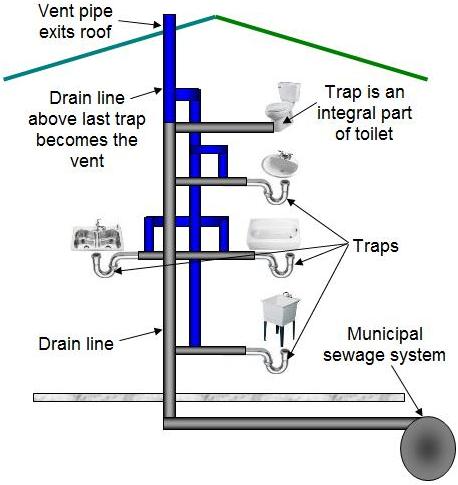
Figure 1 - House drain system
Note: Figure 1 is a representation of a home’s drain system. It is not meant to represent methods of connection, joint distances, pipe angels or positioning. Building codes are very explicit as to pipe sizes, distances between vent pipes or stacks, angles of connecting pipes together, etc.
The basic drain system is no different in a $50,000 or $10,000,000 home. Every residential drain system is made up of three basic components:
Drainpipes:
Drainpipes carry the waste from each plumbing fixture to the main drain line and then on to the municipal waste system. The drainpipes are different sizes, basically starting off at the specific plumbing fixture as a 1 1/4 or 1 1/2 inch pipe (with the exception of the toilet which uses a 3 or 4 inch pipe). These drainpipes will then connect to a drainpipe which is larger, 3 or 4 inches. When the system is working properly the waste in the drainpipes flows freely from the plumbing fixture out to the municipal sewage system. Any blockage in the line can cause waste to back-up though the drain in the plumbing fixture and flood the area. Hence, it is crucial that all drainpipes be clean.
Figure 1 shows the drainpipes and their connections in dark grey.
Vent Pipes or Stacks:
In order for waste to flow freely out of your home and on to the municipal sewage treatment plant, air must be available within the drainage system. Air in the drain system is supplied by vent pipes. These pipes are connected to the drainpipe and run to the highest point of the home – the roof. The vent pipes or as it is commonly termed the vent stack, penetrates the roof providing the air necessary to promote the free flow of waste in the drain system. A clogged vent pipe can create serious problems as air must be drawn into the drain lines at some point. If the vent pipes are clogged and not working properly, the air required can be drawn through other plumbing fixtures. Besides the noise that this creates it can be harmful to the health of the family as it can suck the water out of traps and leave them dry permitting sewer gas to enter the home.
Figure 1 shows the vent pipe and their connections in deep blue.
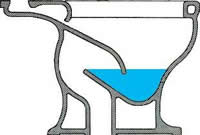
Figure 2 - Toilet bowl trap
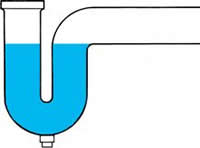
Figure 3 - P-Trap filled with water
Traps:
Every plumbing fixture, if installed properly is connected to the drainpipes through a trap. In most cases the trap is an external piece of plumbing that connects the drain on the plumbing fixture to the drainpipe. The one exception is a toilet. Toilets have an integral molded trap designed into the molding, as shown in Figure 2.
The primary function of the trap is to provide a barrier against sewer gas. The trap is filled with water, as shown in Figure 3, which prevents sewer gas from exiting the drainpipes through the specific plumbing fixture. This allows the sewer gas to exit the home through the vent pipe.
There are numerous plumbing fixture traps. The most common are; P-Traps – Figure 4, S-Traps - Figure 5 and Bottle Traps – Figure 6. They all work in a similar manner and the differences are primarily to facilitate convenient installation and the finished appearance of the project.
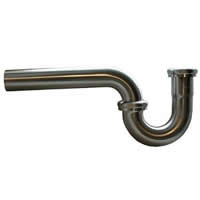
Figure 4 - P-Trap
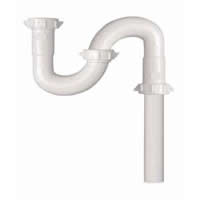
Figure 5 - S-Trap
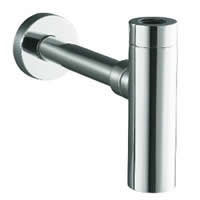
Figure 6 - Bottle Trap
Note: The water that is captured in the trap of the plumbing fixture is open to the air through the drain of that specific plumbing fixture. The overall drain system’s health is predicated on the basis that there is water in all of the traps. Traps can dry out! Traps need to have water added to them on a regular basis in order to ensure that the traps are full of water. If you go on an extended vacation, have the person that you have checking your home flush the toilets and turn the water taps on for a few minutes every three or four weeks. If you have a guest bathroom that is not used often you should flush the toilet and run the water in the bathtub, stall shower and sink for a couple of minutes to ensure that the traps are full of water. If you do not fill the traps with water sewer gas may enter the home, not something you want to face after arriving home after an extended vacation.
